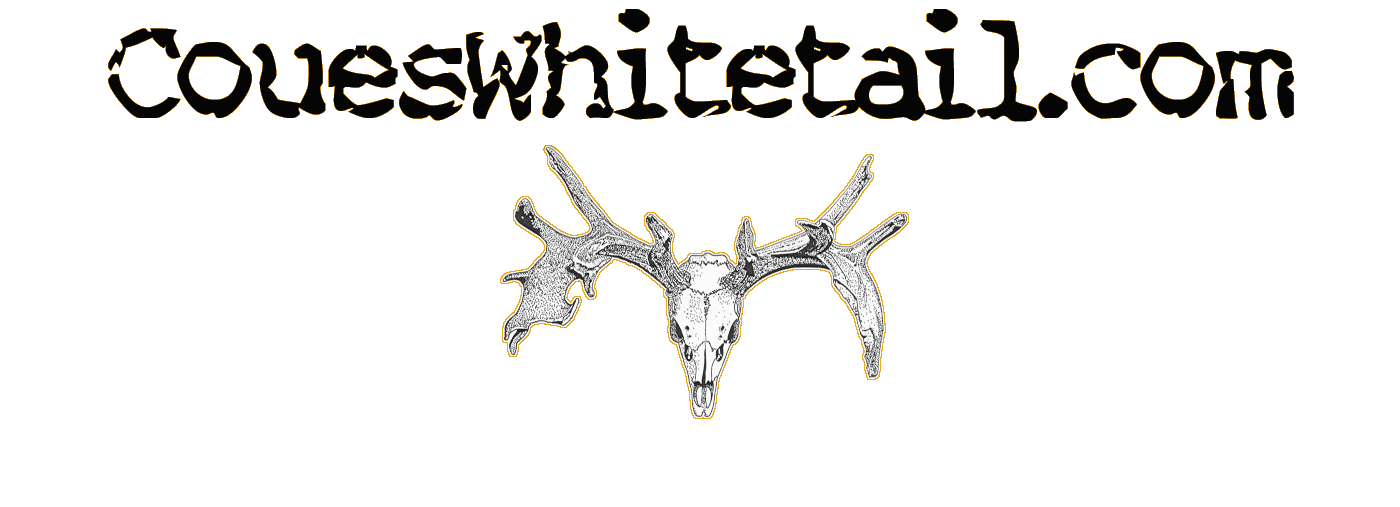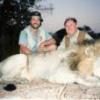-
Content Count
2,887 -
Joined
-
Last visited
-
Days Won
23
Posts posted by billrquimby
-
-
If an animal will breed and produce hybrid offspring with a goat but not a sheep, it is more goat than sheep. Calling them rams, ewes and lambs is like calling a male elk a buck, a female whitetail a cow, a young duck a gosling, or a baby coyote a kitten.
hoghntr: I didn't like the taste of my desert bighorn, but I do like cabrito when it's prepared properly.
Bill Quimby
-
 2
2
-
-
After seeing threads about aoudad hunting on this and another forum, I thought someone would want to know they are NOT sheep, even though that's what many experienced international hunters call them.
These critters actually are closer to goats than sheep, and to be correct, the males should be called "billys," the females "nannies," and their young "kids."
Below is from the SCI Record Book.
Bill Quimby
Aoudad or Barbary Sheep - Africa
Ammotragus lervia
Arrui (Spanish), Mähnenschaf (German), Mouflon à manchettes (French). Also called arui (Arabic)."Aoudad" seems to be an anglicization of its Tunisian name “udad,” and is a better name than Barbary sheep, because this animal is not really a sheep, and is found in many parts of northern Africa besides the former Barbary States or Barbary coastal region. The name "Barbary" originates from the Berber people, the chief inhabitants of the region.
DESCRIPTION Shoulder height 36-40 inches (91-102 cm). Weight 200-250 pounds (90-115 kg).
The aoudad is a medium-sized mountain animal that is biologically intermediate between a goat and a sheep. It is strongly built, with a short mane on neck and shoulders and long flowing hair on throat, chest, forelegs and tail. The general color is sandy brown, with underparts paler. As in goats, the aoudad has a scent gland beneath the tail, but does not have glands between the hoofs, in the groin area or in front of the eyes. Its chromosome number is 58, which is the same as in the urials, but is different from the 60 that is universal in true goats. Aoudads will hybridize with domestic goats, but not with sheep. The horns (both sexes) are sheep-like, being smooth, thick, triangular in section, and curved to form a semi-circle over the neck (supracervical horns). Females are much smaller than males and lighter in color, with less hair and much smaller horns.
BEHAVIOR Usually lives in small family groups with an adult male. Old males and pregnant females may be solitary. Breeds mainly from September to November, but there is some activity throughout the year. A single young (often two) is born 5-1/2 months later. Newborns are able to get about in moderately rugged terrain almost at once, and are sexually mature at about 18 months. Females have been known to give birth twice in one year. Captives have lived as long as 20 years.
Feeds early morning and late afternoon, resting in shade at midday. Eats grasses and foliage, sometimes standing on its hind legs to browse. Drinks water where available, otherwise obtains moisture from its food. Will descend from rocky terrain in evening to feed on plains. Eyesight and hearing are very good, sense of smell is good. Alert and wary. An agile climber and jumper.
HABITAT Rocky mountains and desert hills.
DISTRIBUTION Desert hills and mountains of northern Africa from Morocco and Mauritania eastward to Libya and Chad. Also in northeastern Sudan. Believed extinct in Egypt.
Has been introduced on private ranches in South Africa, which is far outside its natural range, and also in Spain, Mexico and the United States.
REMARKS The aoudad is a superb game animal that is difficult to hunt under almost any circumstances.
TAXONOMIC NOTES Five extant subspecies are listed: angusi (Niger), blainei (Libya, Sudan), fasini (Libya, southern Tunisia), lervia (Morocco, northern Algeria, northern Tunisia), and sahariensis (western Sahara, Mauritania, Mali, southern Algeria, southern Libya, Chad). Their limits are unclear and we do not separate them. A sixth subspecies, ornatus, formerly occurred in Egypt, but is believed extinct.
STATUS The aoudad may never have been common in northern Africa because of its limited habitat in the desert environment. In recent years, its numbers have been reduced in many places from overhunting by local people, to whom it represents an important source of meat, skins and other parts; however, it is believed to still occur in much of its original range. To the best of our knowledge, Chad and Sudan are the places it can be hunted today in its natural range.
-
 6
6
-
-
Arizona's most famous plane crash site is in the Grand Canyon. The following is from Wikipedia:
"The 1956 Grand Canyon mid-air collision occurred on Saturday, June 30, 1956, at 10:30 am Pacific Standard Time when a United Airlines Douglas DC-7 struck a Trans World Airlines Lockheed L-1049 Super Constellation over the Grand Canyon within the boundaries of Grand Canyon National Park, resulting in the crash of both airliners. All 128 on board both flights perished. It was the first commercial airline crash to result in more than 100 deaths, and led to sweeping changes in the control of flights in the United States. The location of the crash has been designated a National Historic Landmark."
On my first raft trip down the canyon in about 1970, there were blue airliner seats scattered all across a certain hillside above us and the raft guys pulled over to the beach, allowing passenger to climb up to them. My other trips down the canyon were in the late 1980s and mid-1990s, and although we didn't stop we saw a few blue seats that hadn't been removed yet.
Incidentally, rafting the canyon is something I'd do again in a heartbeat, even at age 80.
Bill Quimby
-
 1
1
-
-
Chances are the wreck you found is much older than 30 years if was a military plane. There are many crash sites in Arizona's back country, especially in the Rincons and Galliuros. Tucson's Davis Monthan Air Force Base was a flight training site beginning even before WWII, and more than a few pilots-in-training crashed and died.
My father-in-law and I found a crash site on China Peak in the Galliuros in the late 1950s and reported it when we returned to Tucson. We were told that particular site was known, but that we should report any others we might find because there still were wrecks that hadn't been found.
Bill Quimby
-
Yotebuster:
Your bag on geese and ducks reminds me of Yuma in the late 1940s and early 1950s, when there still were big flights there. If I'm remembering correctly, the limit was five "dark species" geese per day. Cranes were protected, but I never saw one near Yuma.
Bill Quimby
-
I’m of the old school, I guess. It’s my belief a wildlife agency should not mandate hunting techniques, methods and ethics unless it can be shown such things are detrimental to wildlife or to our hunting heritage.
As for hunting ethics, the definition I like is that these are practices accepted by the majority of hunters in a region. This is important because ethics vary everywhere there is hunting. For just one example, hunting deer with dogs is legal and ethical in some southern states, but illegal and unethical nearly everywhere else.
I do not use trail cameras for hunting, but it’s because I have no need for them. I no longer am interested in antler size, and tracks show me everything I want to know. That said, what does it matter if there are a dozen cameras in every tree around a pond?
Bill Quimby-
 3
3
-
-
No advantage for me. I'm legally blind in my left eye. Even so, I never had a problem using my Leica spotting scope with just one when I still had two good eyes.
Bill Quimby
-
Congratulations to you and Peg, TJ.
Hope you can visit us at the cabin this summer. You will be surprised at what we've done since you two were there.
Bill
-
 1
1
-
-
In my era, kids didn't grow up wearing backpacks because schools still had lockers. When we hunted, if something didn't fit in our pockets or attach to our belt, it stayed home. As a result, the only pack I've ever owned was a packboard. I never felt deprived except when packing out javelinas. With small deer, we split the knuckles on their forelegs, so we could run their tendons through the gambrels, and wear them (head down) like a pack. Javelinas are too small to do this with them, and carrying them by using their gambrels for handles quickly became a chore. Some friends and I eventually came up with a better way. We took a 12-inch-long, 2-inch-wide strip of leather and punched a hole on each end. In each hole, we tied a 6-inch loop made from a leather bootlace. One loop would go around a javelina's rear leg, the other loop would go around the javelina's jaw. Rigged like that, we could carry a javelina on one shoulder with both hands free. We called them "javelina slings."
Incidentally, they are collared peccaries, not "collard." The name comes from the light-colored hair between their heads and forelegs.
----- Bill Quimby
-
 2
2
-
-
I have a Coleman fiberglass Scanoe with a square stern. I also have a lightweight kicker outboard for it. (I think it is 3hp). I would like to sell both, but they are in Greer and I will not get back there until spring. PM me if you're interested. Canoe paddles would be included.
Bill Quimby
-
Welcome back, Scotty. I seem to remember we had plans for another lunch before you left. Maybe we can find another friendly maître d'.
Bill Quimby
-
 1
1
-
-
"70 decades has got to be a misprint!!!!!!"
Yes it was, but I must say it sure seems like I shot that buck 700 years ago.
Bill Quimby
-
 1
1
-
-
Those who say you would shoot, shovel and shut up if you came upon a wolf need to realize the penalty for shooting a wolf in Arizona is beyond severe. If found and convicted, you would be subject to prison time, a huge fine and the loss of certain rights, including the right to vote and own/possess firearms. It isn't worth it.
Bill Quimby
-
My first deer was mounted and is at our cabin. It still has the metal tag I put on it in 1948.
The mount itself is in awful shape. The taxidermist didn't put forms in its ears, and they now are shriveled and wrinkled. The eyes bulge out, the nose is cracked, and the cape has shrunk, leaving a two-inch wide gap down the back of its head and neck.
Sorry to say, I have not fared much better after nearly seventy decades.
Bill Quimby
-
 6
6
-
-
I bought a lot of those metal tags over the years before Arizona went to sticky-back paper tags. They made a big bump in my wallet back then.
I've got some on a couple of mounts at the cabin, but none down here to tell how the numbers are positioned. They should tell you the year the tag was valid and the tag number.
Don't remember if they will tell you the species, but I do know AG&F was the acronym for the Arizona Game and Fish Department before two-letter postal abbreviations came into being.
Bill Quimby
-
"That's correct after the economy has stabilized and found a new normal level based on it, but inflation does not happen over night it takes time. There will be an immediate influx of larger amounts of cash, which nets a near term benefit." ............
---------------------------------------
Mattys281 : That near-term benefit from an immediate influx of large amounts of cash in the marketplace is only brief, and can also be inflationary.
The data Edge published shows inflation in the U.S. has caused the cost of living to outpace government-mandated minimum wage increases every 3.5 years over the 79 years covered.
When I joined the workforce with my first hourly job in 1950 at age 14, the minimum wage had just been increased to $0.75 hour. The arguments pro and con for government intervention in the minimum wage then were the same as today.
The economic law my Econ 101 professor cited all those years ago has been proven time after time, but is mostly ignored so Ill cite it again:
Government-mandated minimum wages are inflationary and provide only temporary relief to entry-level/bottom-tier workers.
Bill Quimby
-
That senator knows taking the issue to voters ended mountain lion hunting in California, and a similar ballot measure would end it here. He and his supporters are convinced that wildlife requires total protection, and they cannot be convinced otherwise. Their bias against hunting cannot be changed with facts.
Bill Quimby
-
 2
2
-
-
Higher minimum wage legislation does not benefit government, because the inevitable inflation that results also affects the cost of government.
For an example of inflation at its worst, look at pre-World War II Germany and 1990s Zimbabwe, where at its peak one million German marks and Zim dollars wouldn't buy a bottle of Coca-Cola.
Bill Quimby
-
I'm interested in knowing how many wolves it took put the elk down, and how long it took to reduce it to a pile of bones.
We've had wolves and elk come together at our cabin in Greer, but the elk got away -- then.
Bill Quimby
-
 1
1
-
-
The chart Edge provided is proof enough that government-mandated minimum wage increases are inflationary and provide only brief benefits for entry-level/bottom-tier workers. The minimum wage in America has never been a living wage, and never will be. Even if there were a Congress dominated by socialists/Marxists and a president named Bernie Sanders (God help us) and the minimum wage became $100.00 per hour (or $208,000 per year), the cost of living would rise and eventually put the poverty level above $208,000.
------ Bill Quimby
-
 1
1
-
-
Forgot to say this happened four years ago. I've since hauled off the tree and built a larger pumphouse with a carport using money from our homeowner's insurance and my own labor and cash. Hope you will be as lucky, Coach.
-
I know how you feel, Coach. When I opened our cabin in Greer, I arrived to find a huge ponderosa about 30 inches in diameter and 40 or more feet tall had fallen over the winter. It could have gone in any other direction without damaging a thing, but it chose to fall square in the middle of our pump house! Fortunately, our pressure tank and well head somehow survived.
Bill Quimby
-
"I think the government setting the minimum wage really has no impact on whether it is a Free Market or not. They are not setting the price of goods/services. Just adding a factor that can drive prices. Has been that way for decades."
Huh? The cost of labor, materials, material handling and sales, along with the usual factors of supply and demand, ultimately determine the price of all goods and services. It ceases to be a "free market" when government mandates any link in this chain ... and government involvement almost always is inflationary.
Bill Quimby
-
 1
1
-
-
Don't hold your breath that Arizona's new minimum wage will be rescinded. It was passed by voters, not the Legislature, and will have to go back to voters to overturn it. That won't happen until the First of Never.
Bill Quimby



AOUDAD -- NEITHER GOAT NOR SHEEP
in The Campfire
Posted · Report reply
It's an Ammotragus lervia.
Bill Quimby